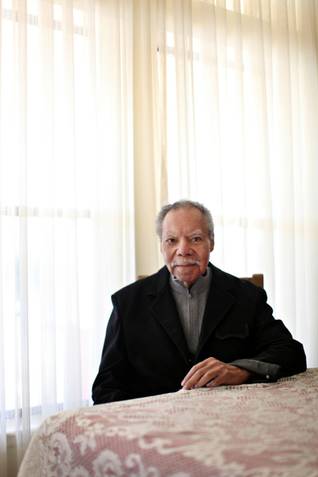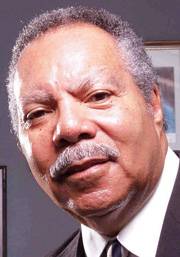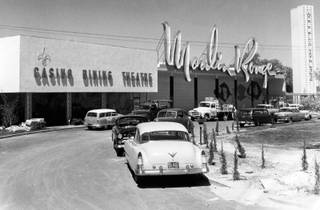
A longtime jazz singer, television and radio personality, civil rights leader and advocate for minority-owned businesses, William H. “Bob” Bailey adds writer to his list of occupations. Bailey is author of a book “Looking Up! Finding My Voice in Las Vegas,” which explores the racism that existed in Las Vegas in the 1950s and 1960s.
Monday, Dec. 14, 2009 | 2 a.m.
Opened Doors

Viewing video requires the latest version of Adobe's Flash Player

Bailey will discuss his book tonight in a televised appearance on "Face to Face With Jon Ralston" on Las Vegas ONE. Bailey will also appear at a book signing at 10 a.m. Tuesday at the CDA Building, 2412 Santa Clara St.
Bob Bailey says it is “humbling, almost embarrassing,” every time he drives by the Dr. William H. “Bob” Bailey Middle School, which has carried his name since 2006.
He shouldn’t feel that way. His is an honor richly deserved.
A longtime jazz singer, television and radio personality, civil rights leader and advocate for minority-owned businesses, the 82-year-old Las Vegan began writing a personal history when his name was nominated for the school. He just couldn’t quit writing and the effort mushroomed into an autobiography, “Looking Up! Finding My Voice in Las Vegas,” published by Stephens Press.
His readers gain a glimpse not only of Bailey and the world of entertainment, but also of an ugly side of Las Vegas history — that of racial segregation in the 1950s and ’60s. One message he wants his book to convey is to “never give up,” even in the face of long odds.
“The possibility of success is commensurate with the patience and fortitude one must elicit to become successful in attaining one’s goals,” he says, pausing with each word for added emphasis.
As the featured vocalist for the famed Count Basie Orchestra in the late 1940s, the Detroit native toured nationally, playing alongside the likes of Harry “Sweets” Edison, Snooky Young and Illinois Jacquet. To take a stroll with Bailey was like walking through a jazz encyclopedia.
When he arrived in Las Vegas in 1955, fresh off a stint as a nightclub soloist, it was to participate in a grand social experiment — the Moulin Rouge — the city’s first integrated resort. As master of ceremonies of the resort’s Tropi-Can-Can revue, Bailey was hoping the show’s success would help keep the doors open, and not just for financial reasons.
“It was imperative that the Moulin Rouge’s policy of integration would be successful and provide a template for the hotels that were running under segregated policies,” Bailey says. “If the Moulin Rouge had been financially successful, it would have inspired the other hotels to integrate to compete for the tourist dollars.”
It was not to be. The Moulin Rouge, drowning in debt, stayed open a mere six months.
The integration of Las Vegas resorts? That would take another 10 years to accomplish.
In the meantime, Bailey and many of the black entertainers he called friends — Nat King Cole, Sammy Davis Jr. and Josephine Baker, to name a few — would continue to confront racism and closed doors at the resorts’ swimming pools and restaurants.
Bailey, though, carved a significant niche for himself in the community. The late Hank Greenspun, founding editor and publisher of the Las Vegas Sun as well as former owner of KLAS Channel 8, made Bailey the city’s first black television personality. Bailey supplemented his weekly television variety show with a role as a radio disc jockey spinning jazz and blues.
His passion for civil rights, though, was never far away. He acquired a taste for community activism while attending Morehouse College in Atlanta. One of his colleagues in the campus glee club was Martin Luther King Jr., the civil rights leader who would inspire millions of Americans to rise up against racism.
Using King as inspiration, Bailey became the first chairman of the Nevada Equal Rights Commission in 1961 and set out on a path to integrate Las Vegas. Around the time when Congress passed the landmark Civil Rights Act of 1964, which integrated public facilities, Bailey helped plan a march to force Strip resorts to end their segregationist policies. It turned out the march wasn’t necessary because the hotels agreed to embrace integration.
“They all complied, but the Sands took the lead because it had a majority of the black artists,” Bailey says.
In later years Bailey turned his attention to the plight of minority-owned businesses, which struggled to gain footing in the community. He did so by establishing the Nevada Economic Development organization and the Nevada Institute of Business. He also served in the first Bush administration as deputy director of the federal Minority Business Development Agency.
To this day, some minority entrepreneurs still find it difficult to establish themselves in certain types of business in Southern Nevada, citing road construction as an example.
“Though we have come a great deal forward in providing equal opportunity for all of our citizens, we still must continue to protect the human gains that have been realized over the past 20 years,” Bailey says. “Liberty and freedom are in constant challenge. We must work together to foster good will among all of us, regardless of the cultural differences that exist in our community.”



 Explore Las Vegas’ past and present
Explore Las Vegas’ past and present Boomtown: The Story Behind Sin City
Boomtown: The Story Behind Sin City Neon Boneyard: A 360° look
Neon Boneyard: A 360° look Mob Ties: See the connections
Mob Ties: See the connections Implosions: Classic casinos crumble
Implosions: Classic casinos crumble
Join the Discussion:
Check this out for a full explanation of our conversion to the LiveFyre commenting system and instructions on how to sign up for an account.
Full comments policy